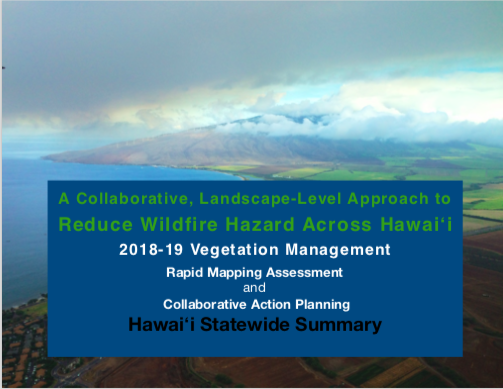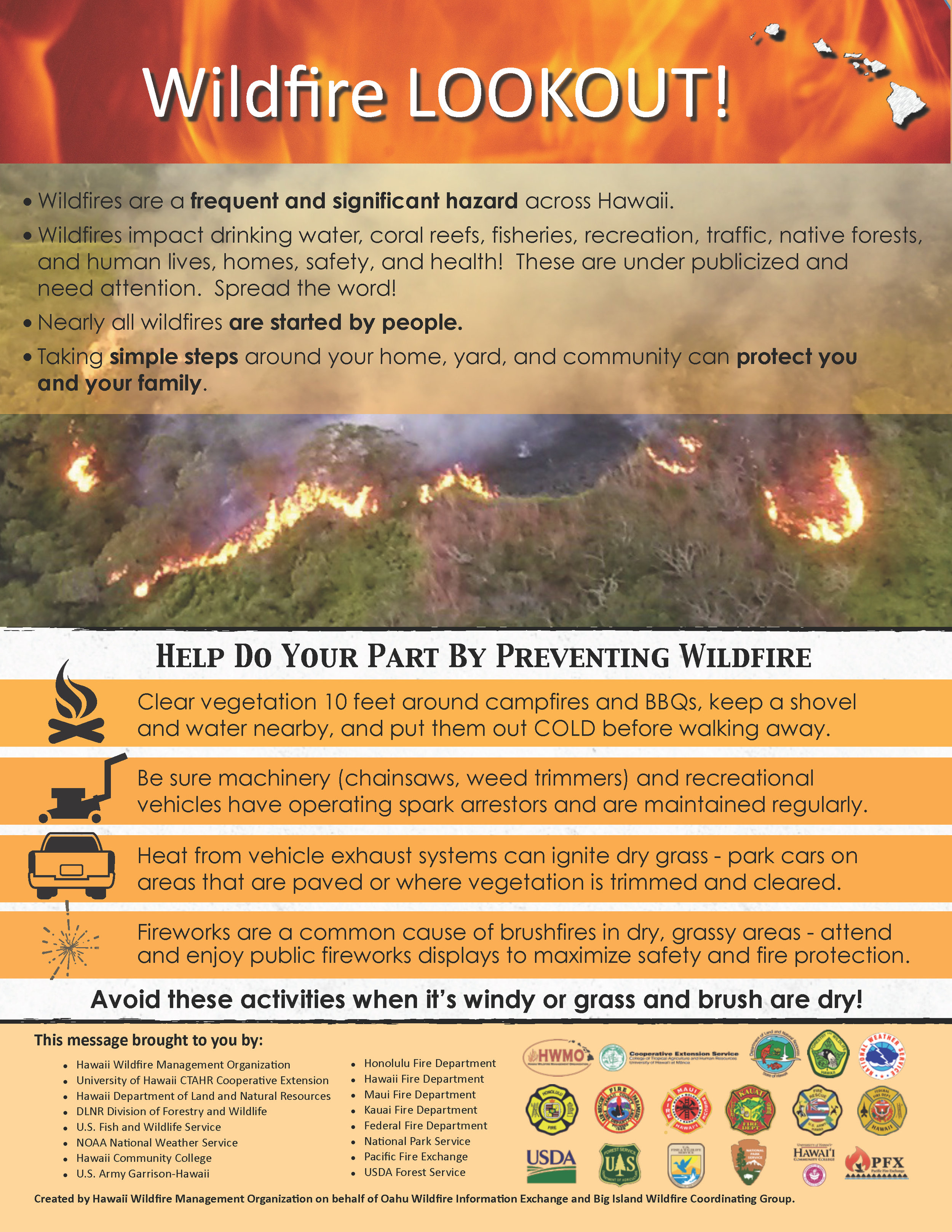CWPP Overview Sheet
HWMO has helped develop Community Wildfire Protection Plan (CWPP) for most of the priority fire-prone regions of Hawaii. The plans assesses values at risk such as safety, natural resource protection, recreation, scenic values, and economic assets. Through a collaborative process involving input from community members, resource management and firefighting agencies, and a variety of other interested parties, CWPPs help bring wildfire hazard information and planning and action opportunities to all parties.
North Shore Oahu CWPP - 2021
HWMO spearheaded the effort to write and implement this 2021 North Shore Oahu Community Wildfire Protection Plan (CWPP).
CWPPs are a great planning tool for communities and have become a prerequisite for receiving federal funding for wildfire protection projects. A CWPP assists a community in identifying and prioritizing areas for hazardous fuel reduction treatments and supports communities to take action. The plan assesses values at risk such as safety, natural resource protection, recreation, scenic values, and economic assets. Through a collaborative process involving input from community members, resource management and firefighting agencies, and a variety of other interested parties, CWPPs help bring wildfire hazard information and planning and action opportunities to all parties. These plans are increasingly important in Hawaii, which faces unique wildfire threats that are becoming more challenging due to increasing ignitions, drought episodes, and land use changes.
Wildfires have great impacts on Oahu residents and natural resources, affecting:
• Daily life (road closures, traffic, evacuations, post-fire flooding, taxpayer dollars)
• Human health and safety (dust, smoke, water quality, burned homes and structures, resident and firefighter safety)
• Ecosystem health and resilience (watersheds, forests, coral reefs, fisheries)
Northwest Hawaii Island CWPP - 2007 (Updated 2016)
Community Wildfire Protection Plans are a great planning tool for communities and have become a prerequisite for receiving federal funding for wildfire protection projects. A CWPP assists a community in identifying and prioritizing areas for hazardous fuel reduction treatments and supports communities to take action. The plan assesses values at risk such as safety, natural resource protection, recreation, scenic values, and economic assets. Through a collaborative process involving input from community members, resource management and firefighting agencies, and a variety of other interested parties, CWPPs help bring wildfire hazard information and planning and action opportunities to all parties. These plans are increasingly important in Hawaii, which faces unique wildfire threats that are becoming more challenging due to increasing ignitions, drought episodes, and land use changes.
Wildfires have great impacts on Hawaii Island residents and natural resources, affecting:
• Daily life (road closures, traffic, evacuations, post-fire flooding, taxpayer dollars)
• Human health and safety (dust, smoke, water quality, burned homes and structures, resident and firefighter safety)
• Ecosystem health and resilience (watersheds, forests, coral reefs, fisheries)
HWMO has helped develop this CWPP and the 2016 update for the Northwest region of Hawaii Island.
Although there is no requirement to update the CWPPs, Hawaii Wildfire Management Organization (HWMO) staff, and technical advisors determined an update would be an important tool to revitalize community engagement and action in wildfire protection and hazard reduction activities. In addition, the community input and action projects needed to be updated. Wildfire hazard is predicted to increase with high vegetation and continued drought.
Community input is critical to making the plan a living document that can be used as a resource to help guide community associations, fire agencies, landowners, and natural resource agencies toward meeting their fire protection goals. The CWPP Update process provided a venue for residents and agency personnel to discuss wildfire concerns and brainstorm solutions together.
Western Maui CWPP - 2014
HWMO spearheaded the effort to write and implement this 2014 Western Maui Community Wildfire Protection Plan (CWPP).
CWPPs are a great planning tool for communities and have become a prerequisite for receiving federal funding for wildfire protection projects. A CWPP assists a community in identifying and prioritizing areas for hazardous fuel reduction treatments and supports communities to take action. The plan assesses values at risk such as safety, natural resource protection, recreation, scenic values, and economic assets. Through a collaborative process involving input from community members, resource management and firefighting agencies, and a variety of other interested parties, CWPPs help bring wildfire hazard information and planning and action opportunities to all parties. These plans are increasingly important in Hawaii, which faces unique wildfire threats that are becoming more challenging due to increasing ignitions, drought episodes, and land use changes.
Wildfires have great impacts on Maui residents and natural resources, affecting:
• Daily life (road closures, traffic, evacuations, post-fire flooding, taxpayer dollars)
• Human health and safety (dust, smoke, water quality, burned homes and structures, resident and firefighter safety)
• Ecosystem health and resilience (watersheds, forests, coral reefs, fisheries)
Ready, Set, Go! Hawaii: Your Personal Wildland Fire Action Guide
Simple Steps to Become Wildfire-Ready
Please share these steps far and wide! We want everyone in our island community to be prepared for wildfire well in advance of an actual ignition.
2018-19 Rapid Assessment of Vegetation Management Results
In Hawaii, wildfire has devastating impacts on our communities and native ecosystems. With land use and climate changes, wildfire is a significant and growing hazard in many places across Hawaii.
Research in wildfire science shows that vegetation is a key ingredient in the recipe for recurring wildfire. Vegetation management is essential for wildfire hazard mitigation strategies that:
reduce wildfire hazard;
create safer conditions for firefighters; and
serve as key climate adaptation strategies for our communities, economies and environment.
Fire follows fuel and the impacts do not abide by property boundaries. Therefore, reducing wildfire hazard is a landscape-level issue that we need to collaboratively tackle together to create safer and more wildfire resilient communities.
In 2015, HWMO’s Technical Advisory Committee, comprised of more than 35 fire and natural resource experts from across the state, discussed Hawaii’s lack of consolidated landscape-level information on vegetative fire fuels treatments.
To start to fill the gap, HWMO conducted a Rapid Mapping Assessment and facilitated Collaborative Action Planning on Vegetation Management in 2018-19 to:
Better understand all of the important hazard reduction already happening by diverse land managers;
Identify and prioritize actions that address the island-wide fire issue to optimize expenditures and efforts and maximize protection at the landscape-scale;
To kick-start collaboration, information sharing, and integrate fire-thinking into current activities to address the cross-boundary fire risk.
We thank State Division of Forestry and Wildlife, University of Hawaiʻi CTAHR Cooperative Extension, and Pacific Fire Exchange for their collaborative support on this project. Funding was provided by Hawaiʻi State Grant-in-Aid Program, 2016, and the U.S. Forest Service, Pacific Southwest Region, under the terms of Grant No. 16-11052012-146 and No. 17-DG-11052012-143. USDA is an equal opportunity provider and employer.
We also thank the many mapping participants, workshop attendees, and survey respondents who made this all possible!
The summary results of the Rapid Mapping Assessment and Collaborative Action Planning can be found below.
Hawaiʻi Statewide Summary
Hawaiʻi Island
Lānaʻi
Maui
Molokaʻi
Oʻahu
Kauaʻi
Wildfire LOOKOUT! Flyer
Wildfire in Hawaii Factsheet
Did you know that the average area burned per year in Hawaii has increased 400% over the past century? Check out this Pacific Fire Exchange fact sheet that presents Hawaii Wildfire Management Organization's State Wildfire History Map and Dr. Clay Trauernichts' key findings from his research on the scale and scope of wildfire in Hawaii.
"Over the past decade, an average of >1000 wildfires burned >17,000 acres each year in Hawai‘i, with the percentage of total land area burned comparable to and often exceeding figures for the fire-prone western US (Fig. 1). Humans have caused much of the increase in wildfire threat by increasing the abundance of ignitions (Fig. 2) and introducing nonnative, fire-prone grasses and shrubs. Nonnative grasslands and shrublands now cover nearly one quarter of Hawaii's total land area and, together with a warming, drying climate and year round fire season, greatly increase the incidence of larger fires (Fig. 3), especially in leeward areas. Wildfires were once limited in Hawai‘i to active volcanic eruptions and infrequent dry lightning strikes. However, the dramatic increase in wildfire prevalence poses serious threats to human safety, infrastructure, agricultural production, cultural resources, native ecosystems, watershed functioning, and nearshore coastal resources statewide."


















